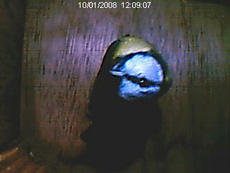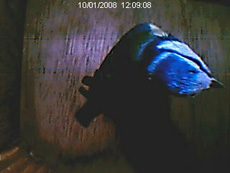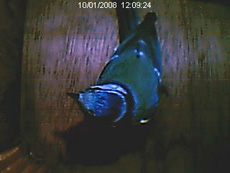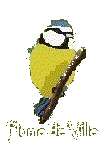Plume de Ville
From day to day.
°°°°°°°°°°°°°°°°°°°°°°°° °
January 1
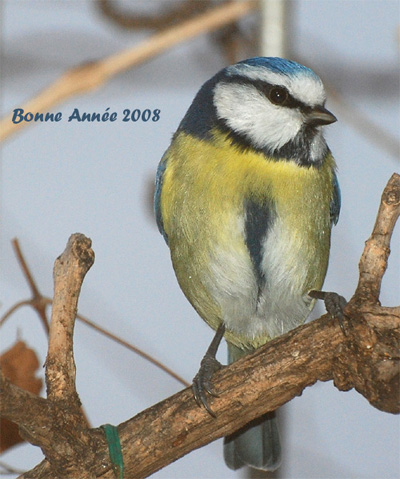
2 January
Cold
again:
0 °C in the morning.
On
the morning, sunshine and the first visit of the year at about 13 hours
when
the sun enters the nest box.
Less than one minute inspection as at
other times.


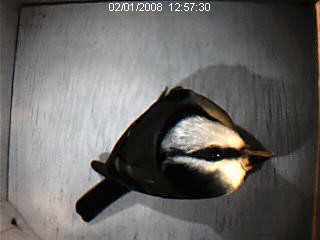
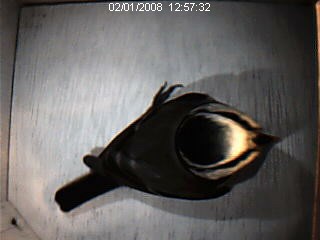
Both blue
tits are very much present and we often see them make a visit at the
entrance
to the nest box. They share the balcony with a couple of great tits.
5 January
Mild,
grey
and rainy.
A
blue tit as usual, comes just at dusk his 17h dinner. There are no
other
birds, it is undisturbed.
It
is dark but we left in the nest box a little lighting. And at 16h58, a
tit
just made a short visit (15 s). I think that the light puzzled her as
when the
sun enters the nest box. It seems that this welcoming light (well,
maybe)
pushes her to enter.
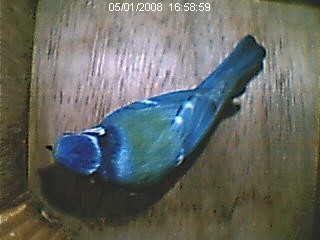
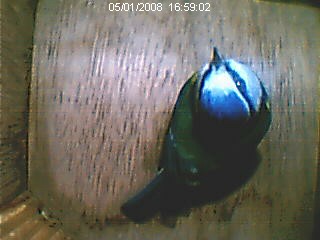
6 January
Mild
weather 10 °C.
In the morning the weather is nice, there is spring feeling and a small patch of sun illuminates just the entrance to the nest box. A tit sings in the birch, visible at the right of the nest.
And
at 10h17
she enters under the sunshine.
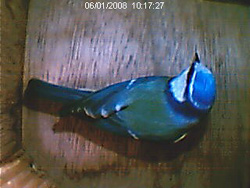
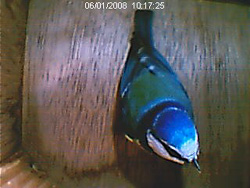
She will
remain two minutes of which a long moment at the door, looking outside.
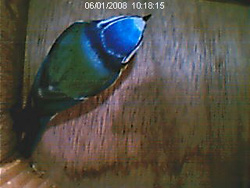
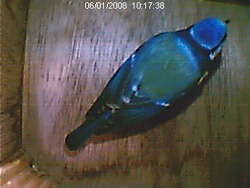
The great
tit would not be outdone and a nice male tries its variations often
perched in
the birch. There are a few branches coming out outside the balcony and
are very
sympathetic to the practice of sounds.
After the freeze
episode, the plants from the balcony had sad look; the viola leaves
hung miserably,
a true "cooked salad." A few days of mildness and they got off the
ground, buds opened. All bulbs grow and clematis have buds. I must not
forget to
prune them before they shoot too much; otherwise I have no the heart to
cut the
young tender green shoots.
8 January
Mild time.
10 °C.
The blue tit comes often to sing on the birch. It is an elaborated
song. There
is something that changed; there were no such songs so far. This
morning, the
first spring pursues (perhaps it is a bit early to say "spring", let's
say "season").
9 January
At a time when the night falls, a little before our blue tit comes to have his nightly dinner, great flights of starlings pass, coming from the south and flying all in the same direction. They fly at the height of buildings in a continuous flight just in face of our windows; some days for about twenty minutes. Sometimes they make a little pause on nearby antennas.
I wondered if they went back to their dormitory in the well protected
enclosed
garden with trees in the centre of the BNF (Bibliothèque
Nationale de France), where
they spent previous winters.
On Friday 4 we took a walk to the BNF. It is 16:15, only a few wood
pigeons and
a few tits are in the pine trees. We continue to the Parc de Bercy
(just across
the Seine River), where there are some ponds, domain of a heron which
sits
impassive on the roof of "its" building. Small starling groups arrive
and noisily perch on the large trees. The groups become increasingly
important.
They group in flight, turn and everybody perches in the same tree! They
discuss
and practice for the concert. Then, suddenly, complete silence, they
have been
switched off, they all fall silent, really everyone. A few seconds of
complete silence,
strange, and then suddenly the whole troupe takes off, in a rustle of
wings to
land on a nearby tree, and the noise resumes abruptly. A hunchback and
noisy crow
accompanies the starlings from tree to tree until it tires and leaves
the
place. Starlings gather here in pre dormitory before heading towards
the
dormitories. Too late for us tonight to accompany them.
8 January. We are at the BNF. In the distance we see the tops of the Bercy tall trees and clouds of starlings taking off and posing. Brrrr! There is a nasty cool little wind that passes between the towers of the BNF, it is very grey and grim. But in rewards, they are here, arriving in large groups and invading the garden. This Tuesday it's too grey for the photo.
9 January:we are back to the BNF. At right, a night view of a corner of
the inner
garden.
It was a grey day but tonight the clouds cover departed and we have a beautiful sunset.
It is 17h10 and small groups of starlings whirl in the sky.
Others
arrive. They form several groups which revolve around the towers, and
then merging and splitting again. Sometimes the mass broke into smaller
groups thathave different ideas about the way to take, and which
revolve around each other, and then found again their friends and
continue their flight. The mass becomes compact and moves like a school
of fish (in fact, which one copies the other?). They fly high,
at
the top of the towers. At one point they disappear behind a tower. We
expect to find them, but disappeared. No more starlings, they will turn
very far. The time to enjoy the beautiful sky and their are back. The
group is even more compact and still others arrive and join them.
The group, increasingly large, fights from tower to tower above the
garden along its entire length. They still flight hight.
Then, gradually, we did not realize it immediately; at each pass they
descend a bit.It is 17h21.
They descended like a heavy ribbon, a little lower at each pass. A last
passage and the head of the troupe plunges into the garden. In an
instant the whole group follows and settles with great shrieking and
jostling.
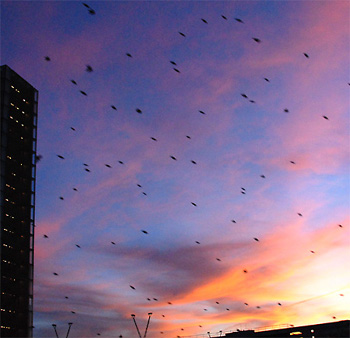
Then, coming from the direction of the Parc de Bercy an enormous cloud
arrives, impressive, the first ones arrive at the BNF and a long ribbon
with no visible end, follows. This time no hesitation, no tour of
exploration, no gentle descent and a swoop arrival, directly in the
garden, they fall in the branches. We almost expect to hear splash!
They dive. There must be protests and feet crushed on the floor below
for those already arrived! The noise is deafening. We do not understand
starling, it is perhaps just as well. A few wood pigeons accompany the
group and dive at the same time.
It's not over. Other major groups coming from the same direction and dive in their turn. It is 17h24.
I can not tell you how many there are. Probably thousands.
Then everything is calm... in the air. There are no more arrivals except for a few latecomers; everyone is looking for its place, moves, jostles neighbours. The space is small; they seek to settle in deep vegetation. They are not easy to see, they can be glimpsed here, piled up. The few wood pigeons present, rant,fly, looking for a small place.
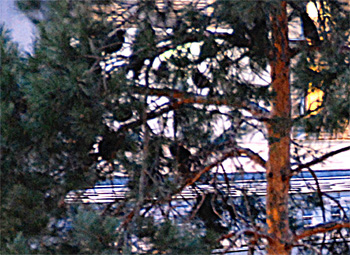
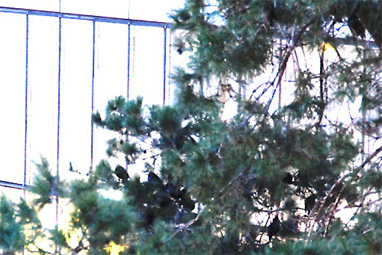
In winter 2006 they were discouraged from staying at the BNF by the intervention of falconers with the kind participation of Harris's Hawk (or Harris Hawk, formerly known as the Bay-winged Hawk or Dusky Hawk). Guano is a goodfertilizer but enough is enough! The trees do not really like it.
It feels a little hint of anxiety when you overflied by great flights, but curiously around the garden, there is little pellets. We hear some fall (and one on me, of course! Well, tradition is respected).
f you want to attend this sumptuous spectacle we must come to 17h15 at the moment at sunset.
Further information made a short tour:
on the site moineau de paris
(récit de l'effarouchement 2006) (story of the 2006 scaring)
and on the site: les
oiseaux en ville .
You can see video on wikipedia (external links): Etourneau_sansonnet
17:15 the same day, our nightly tit makes two short visits of 10 seconds in the evening.

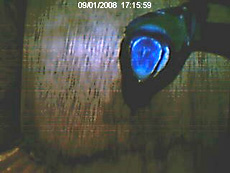
10 janvier
Toujours de la douceur, du gris et de la pluie.
30 secondes de visites vers midi. Et bien sûr, petite visite de nuit vers 17h15.
